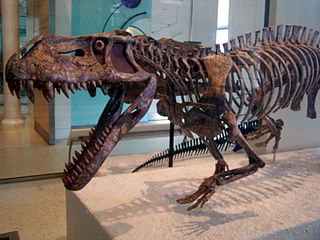 W
WAegeridae is a family of fossil prawns. It contains two genera, Aeger and Acanthochirana.
 W
WArcestidae is an extinct family of ammonite cephalopods.
 W
WCaturidae is an extinct family of fishes ranging from Late Permian to Upper Cretaceous.
 W
WDinodontosaurus is a genus of dicynodont therapsid. It was one of the largest herbivores of the Triassic and had a beak corneum. It lived in the Middle Triassic but disappeared in the Upper Triassic.
 W
WDoswelliidae is an extinct family of carnivorous archosauriform reptiles that lived in North America and Europe during the Middle to Late Triassic period. Long represented solely by the heavily-armored reptile Doswellia, the family's composition has expanded since 2011, although two supposed South American doswelliids were later redescribed as erpetosuchids. Doswelliids were not true archosaurs, but they were close relatives and some studies have considered them among the most derived non-archosaurian archosauriforms. They may have also been related to the Proterochampsidae, a South American family of crocodile-like archosauriforms.
 W
WHeylerosauridae is a family of mastodonsauroid temnospondyls. It was first named in 1980 to include the genera Odenwaldia and Quasicyclotosaurus. In addition to these genera, the family now includes Eocyclotosaurus and Yuanansuchus. Recent phylogenetic analyses have not found a close relationship between Odenwaldia and other heylerosaurids and place it outside the family. Heylerosaurids are generally regarded as the sister taxon of the stenotosaurids.
 W
WLeptolepidae is an extinct family of herring-like Mesozoic teleosts found throughout the world. They were among the first teleosts to have fully ossified vertebrae.
 W
WLeptolepis is an extinct genus of teleost fish that lived in freshwater and marine environments from the Middle Triassic period until the Early Cretaceous. The genus is one of the earliest recognized teleost genera.
 W
WMassetognathinae is an extinct subfamily of cynodonts in the family Traversodontidae. It includes four species from the Middle and Late Triassic: Massetognathus pascuali from Argentina, Massetognathus ochagaviae and Santacruzodon hopsoni from southern Brazil, and Dadadon isaloi from Madagascar. Massetognathines have several distinguishing characteristics, including flattened skulls, small canine teeth, and postcanine teeth with three cusps on their outer edges. Massetgognathinae was defined by Kammerer et al. (2012) as the clade containing all traversodontids more closely related to Massetognathus pascuali than to Gomphodontosuchus brasiliensis, and is the sister taxon of the traversodontid subfamily Gomphodontosuchinae, which was defined by Kammerer et al. (2008) as all traverodontids more closely related to G. brasiliensis than to M. pascuali.
 W
WMerriamosauria is an extinct clade of ichthyosaurs. It was named by Ryosuke Motani in his 1999 analysis of the relationships of ichthyopterygian marine reptiles and was defined in phylogenetic terms as a stem-based taxon including "the last common ancestor of Shastasaurus pacificus and Ichthyosaurus communis, and all of its descendants." The name honours John Campbell Merriam. Based on this definition, Merriamosauria includes most ichthyosaurs except for several Triassic groups such as the clade Mixosauria, the family Cymbospondylidae, and perhaps the family Toretocnemidae. Merriamosaurs are characterized by features in their pectoral girdles and limb bones, including an extensive connection between the scapula and the coracoid bone, the absence of the first metacarpal and the absence of a pisiform bone.
 W
WMetoposauroidea is an extinct superfamily of temnospondyls that lived from the Middle to Upper Triassic in North America, Europe and North Africa. Metoposauroidea includes the families Metoposauridae and Latiscopidae.
 W
WPlacochelyidae is an extinct family of placodonts belonging to the superfamily Cyamodontoidea.
 W
WPrestosuchidae was a polyphyletic grouping of carnivorous archosaurs that lived during the Triassic. They were large active terrestrial apex predators, ranging from around 2.5 to 7 metres in length. They succeeded the Erythrosuchidae as the largest archosaurs of their time. While resembling erythrosuchids in size and some features of the skull and skeleton, they were more advanced in their erect posture and crocodile-like ankle, indicating more efficient gait. "Prestosuchids" flourished throughout the whole of the middle, and the early part of the late Triassic, and fossils are so far known from Europe, India, Africa (Tanzania), Argentina, and Paleorrota in Brazil. However, for a long time experts disagree regarding the phylogenetic relationships of the group, what genera should be included, and whether indeed the "Prestosuchidae" constitute a distinct family.
 W
WThe Ptychitidae is a family of ceratitid ammonites. They are combined with the Eosagenitidae and Sturiidae in the superfamily Ptychitaceae.
 W
WSaurosphargidae is an extinct family of marine reptiles known from the early Middle Triassic of Europe and China.
 W
WTraversodontidae is a family of herbivorous cynodonts. Traversodonts were primarily Gondwanan, with many species known from Africa and South America. Recently, traversodonts have also been found from Europe and eastern North America. Traversodonts first appeared in the Middle Triassic and became extinct in the Early Jurassic diversifying in the Late Triassic. The family Traversodontidae was created by Friedrich von Huene in 1936 for cynodonts first found in São Pedro do Sul in Paleorrota, Brazil.